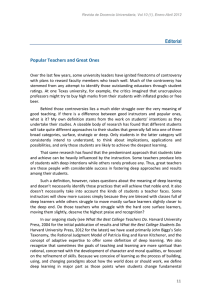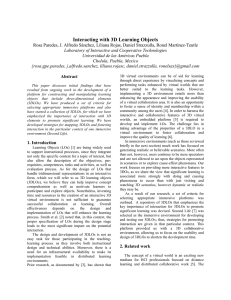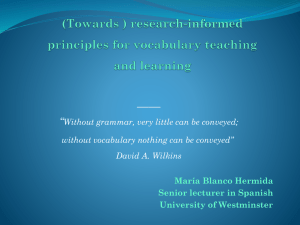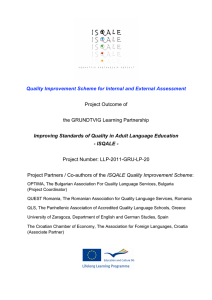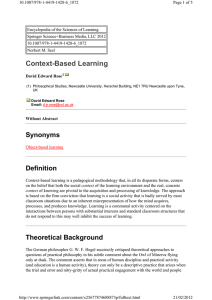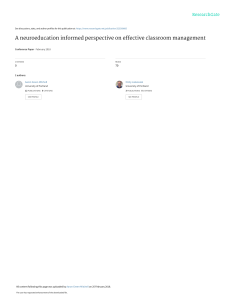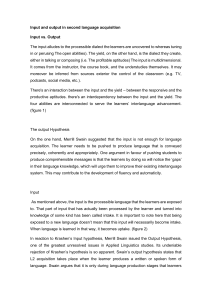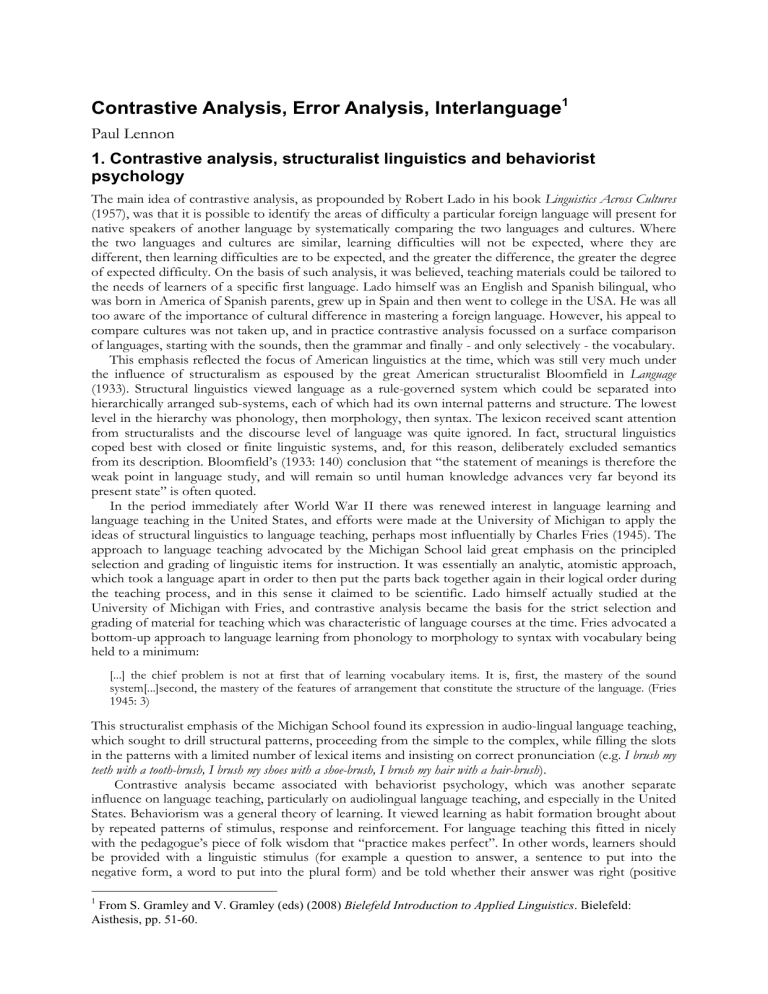
Contrastive Analysis, Error Analysis, Interlanguage1 Paul Lennon 1. Contrastive analysis, structuralist linguistics and behaviorist psychology The main idea of contrastive analysis, as propounded by Robert Lado in his book Linguistics Across Cultures (1957), was that it is possible to identify the areas of difficulty a particular foreign language will present for native speakers of another language by systematically comparing the two languages and cultures. Where the two languages and cultures are similar, learning difficulties will not be expected, where they are different, then learning difficulties are to be expected, and the greater the difference, the greater the degree of expected difficulty. On the basis of such analysis, it was believed, teaching materials could be tailored to the needs of learners of a specific first language. Lado himself was an English and Spanish bilingual, who was born in America of Spanish parents, grew up in Spain and then went to college in the USA. He was all too aware of the importance of cultural difference in mastering a foreign language. However, his appeal to compare cultures was not taken up, and in practice contrastive analysis focussed on a surface comparison of languages, starting with the sounds, then the grammar and finally - and only selectively - the vocabulary. This emphasis reflected the focus of American linguistics at the time, which was still very much under the influence of structuralism as espoused by the great American structuralist Bloomfield in Language (1933). Structural linguistics viewed language as a rule-governed system which could be separated into hierarchically arranged sub-systems, each of which had its own internal patterns and structure. The lowest level in the hierarchy was phonology, then morphology, then syntax. The lexicon received scant attention from structuralists and the discourse level of language was quite ignored. In fact, structural linguistics coped best with closed or finite linguistic systems, and, for this reason, deliberately excluded semantics from its description. Bloomfield’s (1933: 140) conclusion that “the statement of meanings is therefore the weak point in language study, and will remain so until human knowledge advances very far beyond its present state” is often quoted. In the period immediately after World War II there was renewed interest in language learning and language teaching in the United States, and efforts were made at the University of Michigan to apply the ideas of structural linguistics to language teaching, perhaps most influentially by Charles Fries (1945). The approach to language teaching advocated by the Michigan School laid great emphasis on the principled selection and grading of linguistic items for instruction. It was essentially an analytic, atomistic approach, which took a language apart in order to then put the parts back together again in their logical order during the teaching process, and in this sense it claimed to be scientific. Lado himself actually studied at the University of Michigan with Fries, and contrastive analysis became the basis for the strict selection and grading of material for teaching which was characteristic of language courses at the time. Fries advocated a bottom-up approach to language learning from phonology to morphology to syntax with vocabulary being held to a minimum: [...] the chief problem is not at first that of learning vocabulary items. It is, first, the mastery of the sound system[...]second, the mastery of the features of arrangement that constitute the structure of the language. (Fries 1945: 3) This structuralist emphasis of the Michigan School found its expression in audio-lingual language teaching, which sought to drill structural patterns, proceeding from the simple to the complex, while filling the slots in the patterns with a limited number of lexical items and insisting on correct pronunciation (e.g. I brush my teeth with a tooth-brush, I brush my shoes with a shoe-brush, I brush my hair with a hair-brush). Contrastive analysis became associated with behaviorist psychology, which was another separate influence on language teaching, particularly on audiolingual language teaching, and especially in the United States. Behaviorism was a general theory of learning. It viewed learning as habit formation brought about by repeated patterns of stimulus, response and reinforcement. For language teaching this fitted in nicely with the pedagogue’s piece of folk wisdom that “practice makes perfect”. In other words, learners should be provided with a linguistic stimulus (for example a question to answer, a sentence to put into the negative form, a word to put into the plural form) and be told whether their answer was right (positive 1 From S. Gramley and V. Gramley (eds) (2008) Bielefeld Introduction to Applied Linguistics. Bielefeld: Aisthesis, pp. 51-60. reinforcement) or wrong (negative reinforcement). They should be encouraged to repeat correct forms, and, by careful selection and grading of material, possible mistakes should be minimised by the course designer. If mistakes did occur, they were to be immediately corrected by the teacher so that bad habits were not formed. Particular emphasis was placed on the idea that error was to be avoided at all costs, and the idea that one can learn from one’s mistakes found no place in language teaching theory and practice at this time. 2. Error and language interference Error, always a central concern in language teaching, became the central concern in audiolingual approaches. Collections of frequently occurring errors (for example, French 1949) already existed. Traditional textbooks had long paid attention to what were felt to be the errors most likely to occur and tried to guard learners from particular pitfalls in phonology, morphology, syntax and lexis. These areas of special difficulty might derive either from intralingual or interlingual factors. At the lexical level, for example, intralingual difficulties were mooted where minimal formal differences in the foreign language involved major semantic differences (for example “bowl” and bowel”). Interlingual lexical difficulties were mooted typically when a form in the foreign language was very similar to a form in the learner’s native language, but the meaning was different (for example German blamieren and English “blame”). For a long time there was no principled approach to language teaching based on error, but in the late 1950’s and 1960’s this started to change. And the focus shifted very much towards interlingual errors rather than intralingual ones. Highly influential in this regard was Uriel Weinreich’s (1953) publication Languages in Contact. In this book Weinreich displayed his prodigious knowledge of European languages. He was primarily interested not in classroom language learners, but in the way languages influence each other when they come in contact. This is the phenomenon of language interference, with the influence usually being from the stronger language to the weaker one. Weinreich’s great contribution was to posit a psychological or psycholinguistic explanation for language interference. He suggested that any speaker of two languages will tend to identify sounds, words, structures and meanings in one language with corresponding elements in the other language, that is to say, speakers of two or more languages are engaged in a process of making “interlingual identifications” (Weinreich 1953: 7). Many speakers of two languages are thus working with a linguistic repertoire which is more extensive than the repertoire of either language individually, but less extensive than the sum of the two repertoires together, because of the process of interlingual identification which replaces two distinct forms or meanings from the two languages with a single form or meaning which does service for both. These are “compound bilinguals“ in Weinreich’s terms in contradistinction to “co-ordinate bilinguals”, who, in theory at least, have two complete languages separately stored in the brain without any cross-lingual influence operating.2 For the foreign language learner, the usual direction of the influence will be from the mother tongue to the foreign language At the phonological level, this will produce typical foreign pronunciations. The German learner of English may, for example, replace the English weak alveolar [r] sound with a German uvular [r] in English. At the level of structures, the German Perfekt may be identified with the English present perfect tense, for example, and the learner may use the present perfect when he or she would use the Perfekt in German. At the lexical level, English “irritated” may be used to mean the same as German irritiert, “book” made to correspond semantically to Buch, “house”, identified with Haus, and so on. In the case of long-standing immigrants, however, the “new” language may actually begin to influence the mother tongue. Thus, long-standing immigrants are sometimes said to speak their mother tongue with an L2 accent, or to use L2 structures or lexical items when they are using L1, and not just vice versa. Weinreich’s differentiated insights into cross-lingual influence became simplified by those applying them to language teaching, who gave them a deterministic turn. Bright and McGregor (1970: 236), for example, maintained that “the grammatical apparatus programmed into the mind as the first language interferes with the smooth acquisition of the second.” The influence of Eric Lenneberg’s (1967) Biological Foundations of Language perhaps underlies the quotation from Bright and McGregor. Lenneberg suggested that there is a “critical period“ for language acquisition, which ends at puberty, that “foreign accents cannot be overcome easily after puberty” and that “automatic acquisition from mere exposure [...] seems to disappear after this age” (Lenneberg 1967: 176). Lenneberg was a neurologist, and his book was concerned with aphasia based on clinical studies, but his totally unsupported observations on foreign language learning were, mysteriously enough, highly influential on language teaching theory and served to strengthen the already prevalent emphasis on error prevention and eradication. 2 See V. Gramley on bilingualism in this volume. 3. Contrastive analysis as a predictor of error As time went on, various shortcomings of the contrastive analysis approach became apparent. Firstly, although Lado (1957) sought to identify areas of language learning difficulty, in practice contrastive analysis was used to predict error. This assumes that error and difficulty can be equated. This may not necessarily be true since language difficulty is a psycholinguistic concept, whereas error is part of language product. Learners may focus a lot of attention on those aspects of the language they perceive as difficult so as not to make mistakes, and may actually make mistakes in areas where they do not perceive great difficulty. These are the “careless mistakes” in traditional language teaching terms. Contrastive analysis does not provide for the possibility that the learner actively sets about the learning task, but rather sees the learner as a passive recipient of language interference operating in a mechanistic fashion outside the learner’s control. Secondly, contrastive analysis assumed that error derives exclusively from first language interference. Error analysis studies, however, have indicated that certain errors recur among language learners of various L1 backgrounds and seem to be more related to the intrinsic difficulty of the subsystem involved than cross-lingual influence. No matter what your first language is, whether it has prepositions or not, you will almost certainly find it very difficult to make no mistakes in English prepositions. Similarly, even if your language has the category of verbal aspect, you will find it difficult to make no mistakes in choice between simple and progressive verb forms in English. These errors, which learners tend to make regardless of their first language background, are termed “developmental errors”. There has been great controversy in the literature concerning what proportion of the errors learners make are attributable to first language influence. However, contrastive analysis certainly cannot predict these developmental errors. For example, German learners persist for some time in making erroneous choices between “much” and “many” despite the fact that German also makes a formal distinction between singular viel and plural viele. This would not be predicted by contrastive analysis of English and German. The fact that errors may not tell the whole story about learning difficulty was exemplified with respect to avoidance in a famous study conducted by Jacquelyn Schachter (1974) of relative clause used by learners from various language backgrounds. She found that learners whose native languages had relative clauses (Persian, Arabic) actually made more, not fewer, errors in relative clauses than those learners whose languages did not have relative clauses (Japanese, Chinese). However, the Japanese and Chinese learners in the study used fewer relative clauses than Arabic-speaking and Persian-speaking learners. In the case of relative clauses, the learning difficulty which the contrastive hypothesis would predict was manifested in avoidance rather than error, probably because there are various structural alternatives to relative clauses. Other flaws in the predictive power of contrastive analysis have been identified. Not only does contrastive analysis fail to predict some errors, it actually predicts some interlingual errors which do not occur. One category of this phenomenon is related to the uni-directionality of some contrastive errors. Zobl (1980), for instance, found that differences between English and French may not necessarily predict error both for English learners of French and French learners of English. An example is the position of direct pronoun objects, which are placed before the verb in French (le chien le mange) but after the verb in English (“the dog eats it”). English learners of French are more likely to say *le chien mange le than French learners of English are likely to say *”the dog it eats”. This is possibly because English learners of French hear lots of examples of SVO in French (where the object is not a preposition), whereas French learners of English never hear SOV order in English and so are less tempted to follow the word order of their native language (Lightbown / Spada 2006: 79). Learners, particularly good advanced learners, also seem to have hunches about which elements of their language are transferable. Kellerman (1986), working with very advanced Dutch learners of English, found that they were more willing to transfer patterns from their native language to English where the meaning was literal, and unwilling to do so in idiomatic or metaphorical environments. I have found advanced German learners unwilling to accept idioms like “you have a screw loose”, precisely because German uses the same metaphor. Learners’ knowledge of the general patterns of the foreign language may actually lead them into error where the foreign language unusually follows the pattern of their mother tongue. Thus, an advanced English-speaking learner of German may produce erroneous plural forms such as *Streike for Streiks, although the German in this case (exceptionally) follows the pattern of English plural morphology. Contrastive analysis assumed that errors have only one cause, namely influence from the mother tongue. However, it has since been found that intralingual and interlingual factors often combine to produce error. For example, in the acquisition of English sentence negation all learners, regardless of language background, go through the same stages, and at an early stage all learners will use pre-verbal negation (e.g. “no understand”). However, Spanish or Italian learners, whose native language has preverbal negation, are likely to persist with pre-verbal negation longer than German learners, whose language does not have it (Lightbown and Spada 2006: 85). At a later stage of development, all learners will tend to place the negative after the auxiliary. At this stage, however, German learners, under the influence of their L1, which has post verbal negation, may overgeneralise the English rule of negative placement after auxiliaries and produce post-verb negation with main verbs (for example, *”They come not home”), which follows German word order (Lightbown / Spada 2006: 85-86). The contrastive analysis model works best in predicting phonological error. However, errors of morphology, syntax, lexis and discourse are imperfectly predicted by contrastive analysis. Above the phonological level, language planning is far more under the control of the learner, who may adopt certain strategies to cope with difficulty, more or less consciously. These include avoidance of difficult forms and simplification of subsystems of the foreign language. Learners may also make informed guesses about a form not yet acquired (inferencing) and, on the basis of such inferences, try things out in the foreign language (hypothesis testing). These hypotheses are likely to be based on knowledge of the foreign language, the mother tongue, and indeed other foreign languages which the learner may know (Corder 1967, see section 4, below). All this behaviour is ignored by contrastive analysis, which, in keeping with the structuralist linguistic model which underpins it, refuses to admit the possibility of variegated psycholinguistic causes of error. 4. Error analysis It was the British applied linguist, Pit Corder, who re-focussed attention on error from the perspective of language processing and language acquisition. In his seminal (1967) paper “The significance of learners’ errors” he stressed the learner’s positive cognitive contribution to learning. His view was that the learner is engaged in a process of discovering the language. The learner forms hypotheses based on language input and tests those hypotheses in speech production. In this view errors are not only an inevitable but also, very importantly, a necessary feature of learner language, without which improvement cannot occur. Corder coined the term “transitional competence” to indicate the essential dynamism and flux of the language learner’s evolving system. A learner’s errors, according to Corder (1967), represent the discrepancy between the transitional competence of that learner and the target language. Drawing heavily on Chomsky’s (1965) view of first language acquisition, he suggested that just as for the child acquiring its mother tongue the language evolves in a more or less fixed pattern, so the foreign language learner may possess an “inbuilt syllabus” which determines the order in which the language system is acquired and which is largely independent of the order of the external syllabus according to which the classroom learner is ostensibly learning. Corder further suggested that studying error might supply clues to this inbuilt order of acquisition, persistent errors indicating those elements acquired late. Corder, however, invoked Chomsky’s (1965) distinction between “competence” and performance” to draw a distinction between true errors of competence and errors of performance, which he denoted as mere “mistakes”, the product of “chance circumstances” analogous to slips of the tongue in the native language (Corder 1967: 166). These performance “mistakes”, he maintained, say nothing about the underlying speaker competence and should therefore be excluded from analysis. In a later paper Corder (1971: 107-108) suggested that error analysis should include not only “overt” errors but “covert” errors. Covert errors, unlike overt errors, are formally acceptable but do not express the meaning intended by the learner. For example, “I want to know the English” is a formally correct sentence, but it would be a covert error if the learner wanted to express the meaning carried by “I want to know English”. The procedure for error analysis was elaborated by Corder (1974) as comprising five stages: • • • • • selection of a corpus of language identification of errors in the corpus classification of the errors identified explanation of the psycholinguistic causes of the errors evaluation (error gravity ranking) of the errors In fact, error analysis has turned out to be more problematic than one might expect for various reasons. There are problems of identification. Notwithstanding native-speaker intuitions, error is difficult to define and can by no means always be unambiguously identified in production (Hughes / Lascaratou 1982). The distinction between “errors” and “mistakes” is highly problematic since in performance correct and incorrect forms of a single target often occur side by side. Learner transitional competence has been found to be highly variable, influenced by various external factors such as situation, interlocutor, speech versus writing, and certain internal factors, especially anxiety. Furthermore, there appears to be a middle ground between completely acceptable language and erroneous language, which may variously be judged as infelicitous, stylistically inappropriate, non-nativelike, obscure (Azevedo 1980; Pawley / Syder 1983). There are problems of classification. Classification of errors depends on error being localisable to the domains of phonology/graphology, morphology, syntax, lexis, discourse. This is by no means always unproblematic, for example when inaccurate pronunciation or orthography produces another word. Counting of errors becomes problematic when multiple errors occur in close proximity or one error occurs within an already erroneous element. For example “The man is drunken” for “The man has drowned” could be counted as one mistake (“is drunken” for “has drowned”), two mistakes (“is” for “has” and “drunken” for “drowned”), or three mistakes if we add (“drunken” for “drunk”). Burt and Kiparsky (1974) first drew attention to what they called “global errors”, which are difficult to localise to a specific item and seem to extend over the whole sentence. An example might be a sentence like “Well, there’s a great hurry around”. There are problems in assigning psycholinguistic causes. Assigning psycholinguistic causes to error is by its very nature speculative, particularly for global errors. In practice, it is often difficult to decide whether an error is caused by language transfer or not. Often various factors seem to interact to produce error, including first language influence, intrinsic difficulty of the sub-system of the foreign language, but also factors such as communicative strategies have to be considered, where learners have a deficit, perhaps a lexical deficit which they seek to compensate for. To do this, they may coin a word, use an L1 word, anglicise an L1 word, use a more general L1 word, use a near synonym, paraphrase, resort to non-linguistic strategies or appeal to their interlocutor. There are problems of error evaluation. Studies of errors in English have found great differences in error gravity rankings among individual judges who may employ quite different sets of criteria. In particular, native-speaker judges who are not language teachers tend to employ communicative criteria, judging an error as less serious if it does not impede communication and more serious if it does. By contrast, language teachers, and particularly language teachers who are not native speakers of English but are native speakers of the learner’s native language, tend to employ formal criteria, judging errors particularly harshly that violate rules taught explicitly in the early years of formal instruction, for example, the sequence of tenses in conditional sentences. They are also extremely severe on obvious interference errors from L1 (Hughes / Lascaratou 1982; Davies 1983). There is another more fundamental objection to error analysis as a tool for describing transitional competence. At best, error analysis can only provide negative evidence concerning certain aspects of the language that have not been acquired by a learner at a particular time. If learners do not produce any passive verb forms, for example, error analysis cannot say whether they have mastered the passive or not. Learners who are low risk-takers and who work with a restricted code, who avoid structures they are unsure of and do not venture into areas where they feel uncertain, may have relatively few errors. These errors, however, will only very inadequately document the language deficits of these particular learners. It would, therefore, seem preferable, not only to study learners’ errors, but to attempt to describe their language as a whole so as to fully comprehend their “transitional competence”. 5. The interlanguage hypothesis In his famous paper “Interlanguage”, Selinker (1972) built on the error analysis approach of Corder, with whom he worked at Edinburgh University. The main tenet of the interlanguage hypothesis, as formulated first for adult learners (Selinker 1972) and later for child learners (Selinker / Swain / Dumas 1975), is that the language of foreign language learners is itself a linguistic system independent of either L1 or L2, although influenced by both. It will differ from the native speaker system in ways which are systematic, so that the differences between learner production and target norms will not be random. Errors which define these differences to some extent, will be relatively stable over a period of time, and the interlanguage will be mutually intelligible among similar types of learner. Interlanguage is a dynamic system moving in the direction of the target language. The assumption is that by studying learner production access can be gained to the mental processes which underlie it, and that ultimately this will improve understanding of how foreign languages are acquired. The term “interlanguage” thus refers to a language intermediate between the native and the target language. It was derived from Weinreich’s (1953: 7) “interlingual identifications” (Selinker 1972: 211). Selinker actually first used the term interlanguage in an earlier paper on language transfer (Selinker 1969: 71), and at that time he seemed to regard cross-lingual influence as the major influence on interlanguage. For the idea of interlanguage as a dynamic, developing system, however, Selinker was clearly indebted to Corder’s (1967) “transitional competence”. Other terms used at the time to describe the same phenomenon were “approximative systems” (Nemser 1971) and “idiosyncratic dialect” (Corder 1971). Nowadays, researchers prefer to use terms such as “language learner language”. Learner language has empirically been found to be systematic, dynamic, variable and simplified, both formally and functionally, relative to the target language and the learner’s native language (Saville-Troike 2006: 40). Selinker (1972) identified five central processes underlying language learner language which distinguish it from the way in which first language acquisition proceeds: • • • • • language transfer transfer of training strategies of L2 learning strategies of L2 communication overgeneralisation of L2 rules Selinker used the term “language transfer” rather than “interference” to stress the active role of the learner, an emphasis also implicit in Weinreich’s term “interlingual identifications”. By “transfer of training”, Selinker meant the effects of bad teaching. For example, in my own German classes at school we rarely used informal second person plural verb forms (the ihr form) although we had plenty of practice with the other forms, including the singular informal form (du). The result was that when I came to Germany I generally made the correct choice in the singular between formal and informal forms but tended to use the formal Sie form inappropriately for the ihr form in the plural. This was not because of interference from L1 English, where choice in the singular would also have been equally affected, since English does not possess the informal/formal distinction at all, but because of transfer of training. “Strategies of L2 learning” include various attempts to simplify the system which the learner is struggling to master. To avoid cognitive overload learners seem to shut out some distinctions available to them in input and use what they perceive as the most fundamental elements. Examples are learners who use simple present tense for narration in the past, who never use progressive verb forms, who use a base form of the verb without inflectional endings, or who make nearly all nouns, say, masculine in languages which have grammatical gender. Selinker admitted that it is difficult to distinguish “strategies of L2 learning” from “strategies of L2 communication” on the basis of production data alone. The distinction is a psycholinguistic one. In communication strategies, however, the speaker focuses on getting his meaning across and allows inaccuracies in form to be produced to achieve this end. Communication strategies have proved a most fertile field of research since his paper. Selinker’s original idea seemed to be merely that the learner may trade off formal accuracy against fluent delivery so as not to lose speaker attention. Research has since revealed the wide range of strategies to which learners may resort when faced with a communication impasse, either based on L1 or L2 or both. These include word coinage, code switching, paraphrase, avoidance, appeals to the interlocutor, and many more (see Brown 2007: 138 for a review). They may or may not result in error. By “overgeneralisation of L2 rules” Selinker was referring to processes such as extending the “-ed” morpheme for forming past tenses to verbs to which it does not apply (e.g. *”choosed”) or extending the “s” morpheme for forming noun plurals to nouns where it does not apply (e.g. *”sheeps”). However, there has been criticism of this category, and it has been argued that it is really a form of simplification and should more properly be included under strategies of learning. Selinker was aware that although interlanguage is systematic, it is also variable, as his remarks concerning communication strategies show. At any one time, the interlanguage may show forms from an earlier stage of the interlanguage which have not disappeared completely, as well as emergent forms, which are just starting to appear, often alongside the forms they are to replace and which the learner is on the threshold of acquiring (Selinker / Lamendella 1981; Brown 2007: 268). Furthermore, learners may under particular circumstances (stress, anxiety, fatigue, fear, but also when very relaxed, when their guard is down, as it were) “backslide” into earlier stages of their interlanguage (Selinker 1972: 215-216). Finally, Selinker stated that for most learners the interlanguage will stop short of the attainment of native speaker norms and will eventually reach a state where it cannot develop any more despite added instruction or input. He called this putative state “fossilisation“ (Selinker 1972: 215-216). The idea of interlanguage variability was developed most fully by Elaine Tarone (1988). She invoked the concept of an “attentionality continuum”. The learner’s internalised language is, according to Tarone, best accessed by obtaining production in the “vernacular style”, which is in the mid-range of the continuum. High levels of attention to form (“careful speech”, as, for example, in some threatening examination situations) will be just as atypical as speech produced where form is neglected unduly in order to get a message across at all costs (Tarone 1988). Brown (2007: 266-268) suggests that four main stages can be identified in learner language development: a “pre-systematic stage”, “an emergent stage”, “a systematic stage”, “a post-systematic stage”. The pre-systematic stage is characterised by apparently random errors, experimentation and uninformed guessing. The emergent stage involves internalisation of simple rules, some of which may be identical to those of the target language, but many of which will not be. Backsliding is a feature of this stage, as is U-shaped learning, namely apparently going backwards before progressing further. Learners will also avoid structures and topics they cannot cope with. At this stage, learners are not able to correct many of their errors when they are pointed out to them. This changes in the systematic stage. The learner language becomes more internally consistent and also closer to target language norms and learners are more likely to be able to correct their errors when they are pointed out to them. As time goes by, they become able to do this even from indirect corrective feedback provided in conversation. In the final stage, stabilisation has been achieved. Learner speech is now erroneous only to a limited extent, the learner can generally express meaning with more or less precision and is more or less fluent and generally intelligible. There is an ability to self-correct. The above is, however, as Brown (2007: 268) indicates, an idealised picture. Firstly, learners may be at different stages in various domains of language at any one time. Secondly, and this is a fundamental criticism of the interlanguage model, which views learner language as governed by a unitary competence, learners have been found to perform quite differently in different situations, with different interlocutors, according to the task they are to perform, in the classroom versus in the L2 community, and so on. Communicative competence has been shown to be something not monolithic, but to consist of various sub-competences, including linguistic, sociolinguistic, pragmatic, paralinguistic and strategic competence, at least (cf. Brown 2007: 218-222 for a review). For bibliography see Gramley/Gramley 2008
